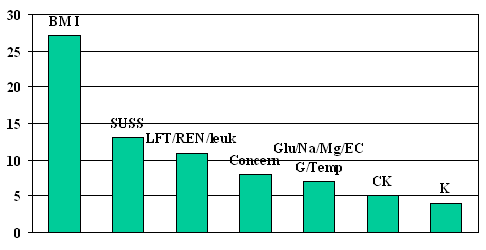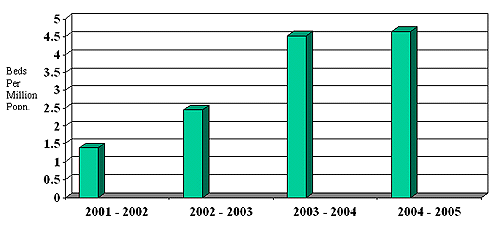The Eating Disorders Service based at the Royal Free hospital in London was established in the 1960s by Professor Gerald russell and is known as the russell Unit. Over the past 8 years it has developed a community-based service for a part of North West London currently comprising some 800000 people.
Conditions treated are anorexia nervosa, bulimia nervosa, binge eating disorder and atypical eating disorders. The team includes personnel from the following professions: Nursing, psychiatry, psychology, family therapy, dietetics, art therapy and massage therapy in addition to administrative staff, a service manager and a clinical lead consultant. The team receives 250-300 referrals per year and provides outpatient, day patient, outreach and liaison.
Day care as part of a comprehensive approach to treatment of eating disorders: The Royal Free Experience.
Paul Robinson.
Consultant Psychiatrist in Eating Disorders
Camden and Islington Mental Health and Social Care Trust
Royal Free hospital, London NW3 2QG
Introduction
The Eating Disorders Service based at the Royal Free hospital in London was established in the 1960s by Professor Gerald russell and is known as the russell Unit. Over the past 8 years it has developed a community-based service for a part of North West London currently comprising some 800000 people. Conditions treated are anorexia nervosa, bulimia nervosa, binge eating disorder and atypical eating disorders. The team includes personnel from the following professions: Nursing, psychiatry, psychology, family therapy, dietetics, art therapy and massage therapy in addition to administrative staff, a service manager and a clinical lead consultant. The team receives 250-300 referrals per year and provides outpatient, day patient, outreach and liaison.
Intake
This occurs on Tuesday morning from 10am to 1pm and involves the consultant psychiatrist, four or more team members who assess new patients, and the outpatients coordinator who records decisions and ensures they are followed through. At 10am each new patient meets for one hour with a team member who could be any member of the team, or one of the students attached to the team. Prior to this meeting the patient has completed a questionnaire sent by post, and this provides a basic level of information. During the interview, staff follow a checklist developed in the unit. At 11am the patient is left to complete a set of standardized questionnaires to measure symptoms of eating disorder, bulimia and depression. From 11am to 12pm each new patient (generally up to 4 in number) is described by the team member and discussed with other members of the team. At 12pm the patient is invited in and has a brief (15 minutes) interview with the consultant during which the diagnosis is confirmed and clarified, treatment options are described and decisions on treatment are made. Patients are aware in advance of the structure of the assessment procedure and sign a consent form permitting the assessment to take place. After the meeting an assessment letter is written by the team member including diagnosis, BMI and treatment followed by history and mental state. This is reviewed and signed by the consultant, and, if requested, a copy is sent to the patient.
Team meeting
This occurs on Wednesday morning between 9am and 12pm. In the first hour the whole team discusses the “Current Concern List”. This comprises any patient giving rise to concern as well as all new patients seen during the previous week. In this meeting referrals are made between team members, at risk patients are identified and management plans developed. The meeting is chaired by a team member, rotating each week. After refreshments at 10am, all day patients are discussed and half the day patients are seen for review.
Liaison Service
A proportion of referrals cannot be dealt with by inviting the patient to attend on a Tuesday morning. Some are in hospital in medical or psychiatric wards, others are severely and acutely ill, a third group are being treated primarily by other teams, such as psychiatric community services, diabetic services, and renal teams. Lastly, some patients find it very difficult to attend hospital, as a result of, for example, agoraphobia or chronic fatigue.
Team members meet with the relevant teams and assess the patient, either at home or in another treatment location, bringing back information to the Wednesday morning team meeting for review and advice.
Outpatient Therapy
The majority of patients seen in the assessment clinic are offered individual therapy, which may be cognitive-behavioural, supportive or psychodynamic. A proportion are offered family therapy and those with bulimia nervosa or binge eating disorder are offered a CBT Group. Families are also invited to attend a monthly family support group and regular multi-family groups are organised. In addition, patients may be offered massage therapy and specific groups such as assertiveness and body image.
Information is also available to patients about self help groups and books. Team members seeing patients for individual or group therapy receive regular expert supervision and family therapy is live supervised.
Day Hospital
Patients referred to the day hospital need to satisfy a number of criteria. They need to have good motivation, not to be in a grave physical state (generally BMI is over 14), and are expected to attend the prescribed program and gain weight. Patients attend for five days per week, having three meals and two snacks each day, the level of intake varying with nutritional needs. They attend a programme of group therapy including a psychodynamic open group, art therapy, post meal groups, weekend planning and review groups, relaxation and other groups. They also have a weekly key worker session, and generally see a family therapist.
Physical monitoring in eating disorders
Patients at substantial physical risk are offered intensive physical monitoring. These patients include the following:
1. Rapid weight loss (>1kg per week)
2. BMI under 14
3. Hypokalaemia or other electrolyte imbalance
Monitoring varies between patients, but may include the following:
1. Body weight and BMI
2. Muscle strength (SUSS test)
Sit Up (SU): The patient is asked to lie flat on the (clean) floor) and sit up, without, if possible, using her hands.
Squat Stand (SS): The patient squats and stand up.
Scoring: 0: Patient unable to sit up or stand up
1: Patient able to sit up or stand up only by using hands
2: Patient able to sit up or stand up with noticeable difficulty
3. Patient able to sit up or stand up with no difficulty.
3. Blood analysis: Electrolytes, liver function, Creatine Kinase
4. Electro Cardio Graph: Especially signs of ischaemia or prolonged QT interval on ECG
It is recommended to use a variety of measures, because no one measure is totally reliable, and patients sometimes falsify their weight, eg by water loading before weighing. Also, if a patient is at a low stable BMI, but all other measures are normal, they have probably adapted to low weight and urgent refeeding may be unnecessary or even dangerous.
Hospitalization
The decision about admission to hospital should be taken with due regard to the history, and all the above physical monitoring data. Most commonly it is considered because of falling weight and a filing system, eg rising LFTs or CK, or an abnormal ECG. Hypokalaemia may trigger admission, because of fear of arrhythmias, and psychiatric admission may be sought because of suicidality or self harm. The choice of bed varies between a medical bed if physical state is very severely compromised, or if an intravenous infusion or a cardiac monitor is required, a general psychiatric bed for self harm and, sometimes, for refeeding, and a specialist inpatient unit for refeeding.
Follow up data from the Royal Free
Treatment provided to patients seen after referral
A review of the 176 consecutive patients assessed after referral to the service within the last 2 years showed that 89% were treated entirely as outpatients, 8% as day patients and 3% were admitted to hospital.
Bed utilization
In the first three or four years of the day service (1997-2001) very few beds were used. However, severely ill patients were referred once or twice a year and by 2002, bed usage had begun to increase to a maximum of around 4. 5 beds per million population.
Figure 1: Bed usage per million population
Reasons for admission
Legend: BMI Body Mass Index. SUSS: Sit Up Squat Stand test, LFT: Liver function tests. REN: Renal function. Leuk: White blood count. Concern: Extreme concern by professionals or relatives. Glu: Glucose. Na: Sodium. Mg: Magnesium. ECG: electroencephalogram. Temp: Hypothermia. CK: Creatine Kinase. K: Potassium
Figure 2: Reasons for 36 hospital admissions among 20 patients. Multiple reasons for admissions were common.
All admission between 1997 and 2003 were studied and reasons for admission deduced from case notes. From Figure 2 it can be seen that falling BMI was the most common reason for admission with deteriorating results on the SUSS test next most common. Other reasons included abnormal electrolytes, liver function, creatine kinase, body temperature and low leukocyte count. In two cases, admission was arranged primarily because of extreme concern of relatives or other consultant psychiatrists. The majority of admission (75%) were to specialist inpatient facilities for eating disorders, rather than medical or general psychiatric beds.
Outcome of patients attending the day hospital
Outcome is measured using BMI, Eating Disorders Inventory (Garner and Garfinkel, 19**), Beck Depression Inventory (Beck 1996) and the bulimia Investigatoy Test Edinburgh (BITE) (Freeman and Henderson 1987).
BMI:
A follow up of 15 consecutive day patients a mean of 14 months after finishing the day programme showed a significant increase in BMI of +2. 16, (P<. 01, paired t-test). 12 patients gained weight, but only 4 into the normal range. 3 failed to change or lost weight.
Questionnaires
In the same follow up, there were significant reductions in EDI, BITE symptoms score and BITE severity score. BDI depression score reduced, but not significantly.
Discussion
Audit of a well staffed inner city eating disorders service in London has demonstrated that the vast majority of patients can be treated as outpatients. A small proportion require day care and a smaller proportion still require inpatient care, mostly in specialist inpatient units for eating disorders. Admissions tended to increase with time, but it appears that a plateau at 4. 5 beds per million population has been reached. This is a reasonable minimum bed provision for an inner city population, and assumes that there is available a well functioning team with outpatient, day patient and liaison/outreach capacity, and access to a wide variety of psychotherapeutic and medical skills.
Methods of physical monitoring are essential to safe practice with this patient group, and experience has shown that multiple measures are necessary, including BMI, muscle power testing (SUSS test), blood tests and ECG. Frequency of monitoring is decided by responsible physicians, and indications for intensive monitoring includes falling BMI, BMI <14, increasing physical symptoms, eg weakness and electrolyte abnormalities.
Follow up of BMI and questionnaire rating suggests that day care is an effective intervention, although results do not include a control group.
Individual supportive therapy for eating disorders can be provided by staff without specific therapy training provided they are well supported and supervised.
Comprehensive treatment of eating disorders requires input from a wide variety of professionals able to work in diverse settings.
References
Beck, A (1996) Beck Depression Inventory, Harcourt
Garner, D. M. , Olmsted, M. P. and Polivy, J. (1983) The eating disorder inventory: A measure of cognitive-behavioral dimensions of anorexia nervosa and bulimia. In P. L. Darby, P. E. Garfinkel, D. M. Garner and D. V. Coscina (Eds. ), anorexia Nervosa: Recent Developments in Research, (pp. 173-184). New York: Alan R. Liss.
Henderson, M and Freeman, CP, A self-rating scale for bulimia. The 'BITE'. The British Journal of Psychiatry 150: 18-24 (1987)
IMPORTANTE: Algunos textos de esta ficha pueden haber sido generados partir de PDf original, puede sufrir variaciones de maquetación/interlineado, y omitir imágenes/tablas.

